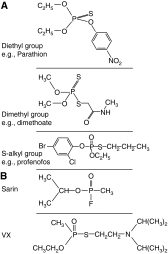Respiratory complications of organophosphorus nerve agent and insecticide poisoning. Implications for respiratory and critical care
- PMID: 25419614
- PMCID: PMC4299648
- DOI: 10.1164/rccm.201406-1150CI
Respiratory complications of organophosphorus nerve agent and insecticide poisoning. Implications for respiratory and critical care
Erratum in
-
Erratum: Respiratory Complications of Organophosphorus Nerve Agent and Insecticide Poisoning. Implications for Respiratory and Critical Care.Am J Respir Crit Care Med. 2019 Oct 1;200(7):946-948. doi: 10.1164/rccm.v200erratum5. Am J Respir Crit Care Med. 2019. PMID: 31573348 Free PMC article. No abstract available.
Abstract
Organophosphorus (OP) compound poisoning is a major global public health problem. Acute OP insecticide self-poisoning kills over 200,000 people every year, the majority from self-harm in rural Asia. Highly toxic OP nerve agents (e.g., sarin) are a significant current terrorist threat, as shown by attacks in Damascus during 2013. These anticholinesterase compounds are classically considered to cause an acute cholinergic syndrome with decreased consciousness, respiratory failure, and, in the case of insecticides, a delayed intermediate syndrome that requires prolonged ventilation. Acute respiratory failure, by central and peripheral mechanisms, is the primary cause of death in most cases. However, preclinical and clinical research over the last two decades has indicated a more complex picture of respiratory complications after OP insecticide poisoning, including onset of delayed neuromuscular junction dysfunction during the cholinergic syndrome, aspiration causing pneumonia and acute respiratory distress syndrome, and the involvement of solvents in OP toxicity. The treatment of OP poisoning has not changed over the last 50 years. However, a better understanding of the multiple respiratory complications of OP poisoning offers additional therapeutic opportunities.
Keywords: critical care; insecticide; nerve agent; organophosphorus.
Figures




References
-
- WHOPublic health impact of pesticides used in agricultureGeneva, Switzerland: World Health Organization; 1990
-
- Eddleston M. Patterns and problems of deliberate self-poisoning in the developing world. QJM. 2000;93:715–731. - PubMed
-
- Sellestrom A, Cairns S, Barbeschi M.United nations mission to investigate allegations of the use of chemical weapons in the Syrian Arab Republic. Report on the alleged use of chemical weapons in the Ghouta area of Damascus on 21 August 2013Geneva, Switzerland: United Nations; 2013
Publication types
MeSH terms
Substances
Grants and funding
LinkOut - more resources
Full Text Sources
Other Literature Sources
Medical
Miscellaneous

